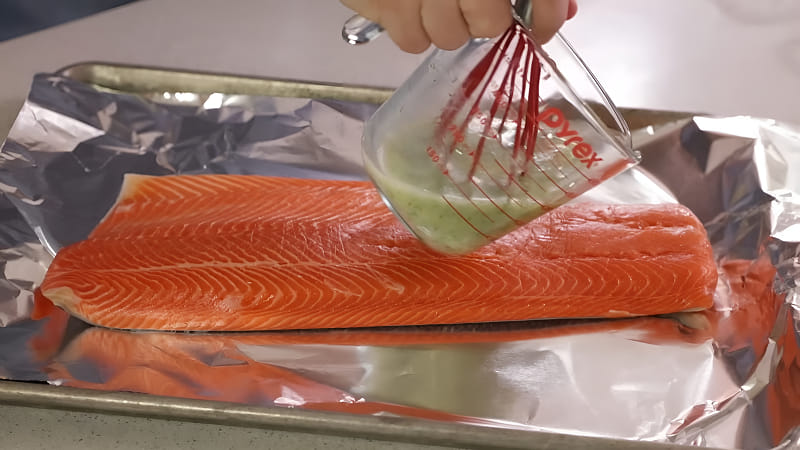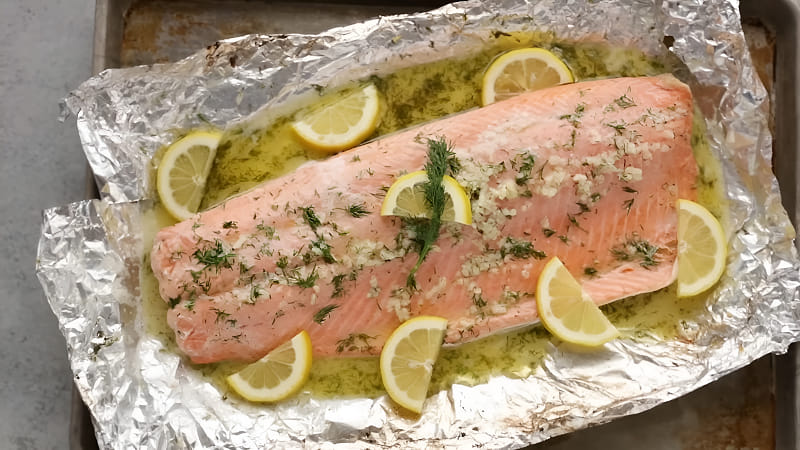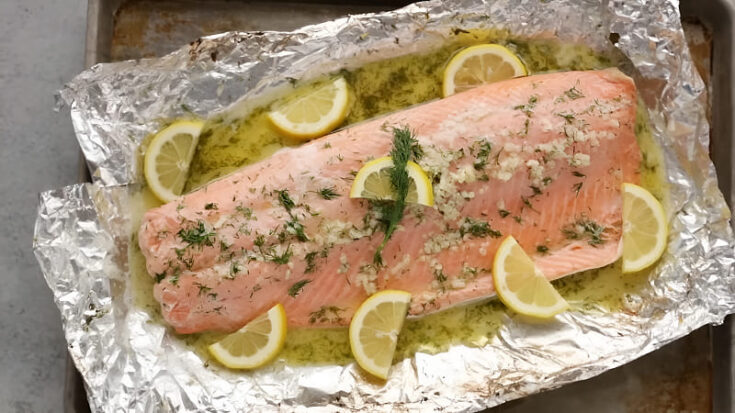Baked Sockeye Salmon is a flavorful and nutritious dish that will delight your taste buds. Whether you are a seafood lover or just looking to add more omega-3 fatty acids to your diet, this mouth-watering dish is the perfect choice. Baking the salmon allows it to retain its natural juices and flavors while creating a crispy outer layer that complements the tender and flaky meat. If you’re searching for a delicious and healthy meal, look no further than this baked salmon.
Benefits of Sockeye Salmon
- Rich in Omega-3 Fatty Acids: Sockeye salmon is packed with omega-3 fatty acids, essential for brain and heart health, and reduces inflammation in the body.
- High in Protein: Sockeye salmon is an excellent source of protein. Including sockeye salmon can help you meet your daily protein needs.
- Good Source of Vitamins and Minerals: Sockeye salmon is a nutrient-dense food that provides various vitamins and minerals required for optimal health. It is particularly rich in vitamin B12, vitamin D, selenium, potassium, and magnesium.
- Promotes Eye Health: The high omega-3 fatty acids in sockeye salmon benefit eye health.
- Supports Heart Health: Consuming sockeye salmon regularly has been shown to improve heart health by reducing blood pressure and triglyceride levels and protecting against plaque buildup in the arteries.
- Boosts Brain Function: The omega-3 fatty acids in sockeye salmon are crucial for brain health and cognitive function. They can improve memory, enhance focus, and reduce the risk of neurodegenerative diseases like Alzheimer’s.
- Anti-Inflammatory Properties: The omega-3 fatty acids present in sockeye salmon have anti-inflammatory effects on the body. This can help alleviate symptoms of chronic inflammatory conditions such as arthritis.
- Weight Management: Protein-rich foods like sockeye salmon can increase satiety and reduce cravings.
How to Choose the Best Sockeye Salmon

First and foremost, freshness is paramount. Look for sockeye salmon that is firm and shiny, with clear and bright eyes. Avoid any fish with dull or cloudy eyes, as this can be a sign of poor quality.
Next, pay attention to the smell. Fresh sockeye salmon should have a clean, briny scent reminiscent of the ocean. It may be past its prime if it smells overly fishy or has a strong ammonia odor.
The color of the flesh is another important indicator of quality. Sockeye salmon should have a vibrant red color, resulting from its diet consisting mainly of shrimp-like crustaceans called krill. Avoid any fillets that appear pale or discolored.
The texture is also key when choosing sockeye salmon. The meat should feel firm and bounce back when pressed lightly. Avoid any fillets that feel mushy or have visible soft spots.
Lastly, consider the source of your sockeye salmon. Wild-caught sockeye salmon is generally considered superior in flavor and sustainability compared to farmed varieties. Look for labels indicating that the salmon was sustainably harvested and caught using methods that minimize environmental damage.
Read more:
Delicious Sides to Serve with Baked Sockeye Salmon
- Lemon Roasted Asparagus: The bright and refreshing flavors of lemon pair perfectly with the savory taste of sockeye salmon. The result is a delightful side dish that adds color to your plate.
- Quinoa Salad: Combine cooked quinoa with diced cucumber, cherry tomatoes, red onion, chopped parsley, and feta cheese. This light and fresh salad provides a satisfying contrast to the richness of the salmon.
- Garlic Mashed Potatoes: Creamy mashed potatoes are always a crowd-pleaser. The creamy texture and subtle garlic flavor make these mashed potatoes perfect for baked sockeye salmon.
- Roasted Brussels Sprouts: Toss them with olive oil, salt, and pepper before popping them in the oven at high heat. The slight bitterness of the Brussels sprouts adds complexity to your meal and balances out the richness of the salmon.
Tips for Perfectly Moist and Flaky Salmon

- Choose the right cut: When selecting salmon for baking, opt for cuts with higher fat content, such as sockeye or coho salmon. These varieties tend to be more flavorful and have a higher oil content, ensuring a moist and flaky texture.
- Season generously: Season it generously with salt, pepper, and your favorite herbs and spices. This will add delicious flavor and help lock in moisture during baking.
- Use foil or parchment paper: Baking salmon in foil or parchment paper helps seal it in moisture and prevent it from drying out. The enclosed environment allows the fish to cook evenly and retain natural juiciness.
- Don’t overcook: Remember that salmon continues to cook after you remove it from the heat source, so aim for slightly undercooked rather than overcooked. The center should still be slightly translucent and easily flake apart with a fork.
- Keep an eye on cooking time: Generally, cook salmon at 425 degrees Fahrenheit for about 12-15 minutes per inch of thickness. However, monitoring your fish closely during cooking is important to avoid overcooking.
- Let it rest: After removing the salmon from the oven, let it rest for a few minutes before serving. This allows the juices to redistribute throughout the fish, resulting in a more tender and juicy final product.
- Serve immediately: Salmon is best enjoyed immediately after cooking while still warm and moist. If you need to prepare ahead of time, lightly cover the cooked salmon with foil to keep it warm until serving.
Baked Sockeye Salmon in Foil Recipe
Ingredients
- 1 pound of Sockeye Salmon fillet
- Aluminum foil
Instructions
- Preheat your oven to 375 degrees.
- Grab a baking sheet and line it with aluminum foil. This will make for easy cleanup later on.
- Place the salmon fillet on the foil-lined baking sheet. Sockeye Salmon is a popular choice due to its rich flavor and vibrant color.
- Now, let's talk about choosing salmon. You have two options: wild salmon or farm-raised salmon. While wild salmon tends to have a better taste, it is usually more expensive. Farm-raised salmon is a more economical choice and is considered better for the environment. It's up to you to decide which one to go for.
- This recipe will work perfectly whether you have a whole fillet or individual portions. Simply adjust the cooking time accordingly.
- Let's prepare a quick and flavorful butter sauce in a separate bowl. Start by melting half a cup of butter. You can easily melt it in the microwave or on the stovetop.
- Once the butter is melted, pour it into the bowl. To that, add four tablespoons of freshly squeezed lemon juice for a refreshing citrus flavor.
- Now, it's time to add some aromatic ingredients. Crush seven to eight cloves of garlic and finely chop about two tablespoons of fresh dill. Add these to the bowl as well.
- Give everything a good whisk so that the flavors mingle together. The combination of dill, garlic, and lemon adds a delightful taste to the salmon.
- Pour the butter sauce mixture directly over the salmon. Ensure that the fillet is fully covered with the sauce. If you're using portions, drizzle the sauce equally over each piece.
- At this point, you'll notice there's excess sauce. To prevent spills, quickly wrap the salmon in the foil, ensuring it's completely covered. Tuck in the ends to seal it tightly.
- Your salmon is now ready to be baked! Place the foil-wrapped salmon in the oven and cook for 15 to 20 minutes.
- The cooking time will depend on the thickness of your salmon. If it's on the thinner side, go for 15 minutes. For thicker cuts, aim for 20 minutes. You'll know it's done when the salmon flakes easily with a fork.
- And there you have it! A delicious Baked Sockeye Salmon in Foil ready to be enjoyed. The butter sauce infuses the salmon with incredible flavors, making each bite truly irresistible.

Hey readers! Chip Holland here, and I’m a Manager of this website. My passion for writing about it only matches my passion for BBQ. Follow my blog for mouth-watering recipes, tips, and tricks for the perfect smoke, grill, and BBQ. I’m sure you won’t be disappointed!

